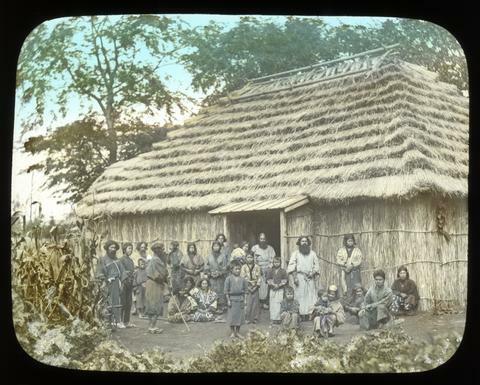Kamuy and Material Culture
The influence of the ramat and kamuy in daily life had a tremendous impact on Ainu material culture. Traditional houses (cise), for example, were constructed according to a strict code to secure the favor and protection of the kamuy. At the very center of the house was the hearth, inhabited by the fire goddess Apehuchi Kamuy, who sustained the family through the harsh winter with warmth and by helping them prepare their meals. Meanwhile, Cise-kor Kamuy, the guardian of the home, occupied the back-east corner of the house. This was the most sacred part of the structure, and it was here that the family kept their most prized treasures called ikor, on the iyoikir “treasure alter.” Because ramat and kamuy could be associated with all manner of natural phenomena and man-made objects, ikor treasures—manufactured goods such as swords, ceramics, lacquers, and textiles that were acquired through trade—also demanded proper respect. After serving their utilitarian functions, these goods were “retired” to the iyoikir, where they were honored for their service to the family.1 (For an excellent illustration of an iyoikir alter, see Elizabeth Keith’s Sketch of Ainu Interior). In addition to ikor treasures, another important commodity associated with Ainu spirituality are ikupasuy. Ikupasuy are “prayer sticks,” individually carved by Ainu men and decorated with geometric patterns as well as animal, plant, and human motifs. Ikupasuy are central to Ainu rituals and ceremonies, and are often used to offer libations of Japanese sake to the gods.2
The objects below are inaw (also spelled inau or inao), ritualistic shaved sticks with whittled tufts at the end. Inaw have been used by many different cultural groups across the Okhotsk-Amur region and continue to play an extremely important role in Ainu ceremonial practices.3 Varying in length, inaw are usually made from the wood of the willow and dogwood trees, and while there are many different styles depending on the prayers, functions, and kamuy involved, they are typically made by shaving the wood smooth at the base of the stick, and leaving curled tufts at the top end. Inaw play an extremely important role in individual prayers and large community ceremonies. Considered to be a sign of great respect to the kamuy, inaw are also believed to help carry one’s prayers and oblations to the “god realm” of Kamuy Mosir. Inaw are prominently displayed in the home as well as in rituals and ceremonies like the iyomante,4 and can be seen in a number of paintings in the JSMA collection.
1.) Shigeru Kayano and Shunʼichi Iijima, The Ainu: A Story of Japan's Original People (Boston, M.A.: Tuttle Publishing, 2004): 22-23.
2.) Chisato Dubreuil “Ainu Art: The Beginnings of Tradition,” Ainu: Spirit of a Northern People, 296.
3.) Richard Zgusta, The Peoples of Northeast Asia Through Time: Precolonial Ethnic and Cultural Processes Along the Coast Between Hokkaido and the Bering Strait (Leiden: Brill, 2015): 42.
4.) Masahiro Nomoto, “Home and Settlement: Kotan and Chise,” in Ainu: Spirit of a Northern People, 231.


